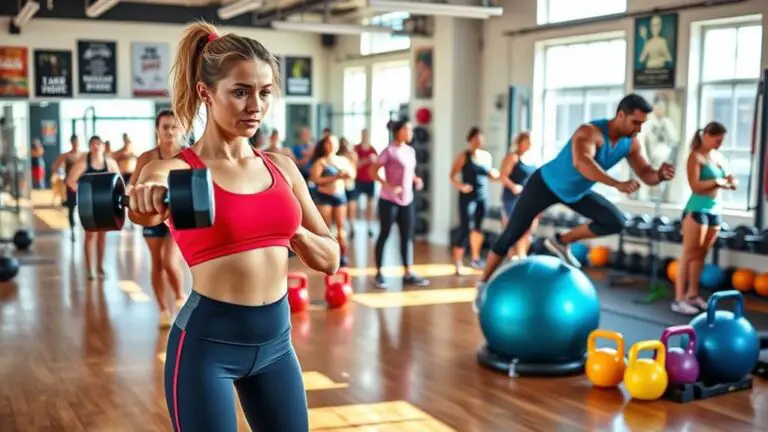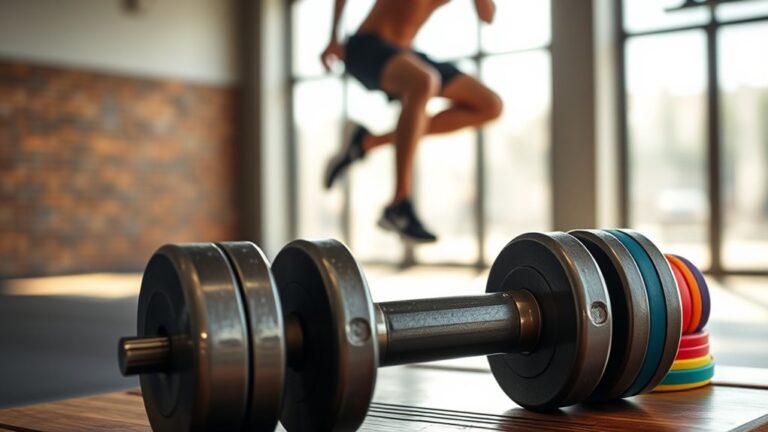How to Train for a Powerlifting Competition

To train for a powerlifting competition, you’ll need to master the squat, bench press, and deadlift while following a structured program. Focus on perfecting your technique and maintaining proper form to avoid injury. Incorporate accessory exercises to strengthen muscle imbalances and enhance your lifts. Pay attention to your nutrition and hydration for peak performance. Finally, prepare mentally for the competition to boost your confidence. Get ready to learn more about each aspect of your training journey.
Understanding the Powerlifting Lifts: Squat, Bench Press, and Deadlift
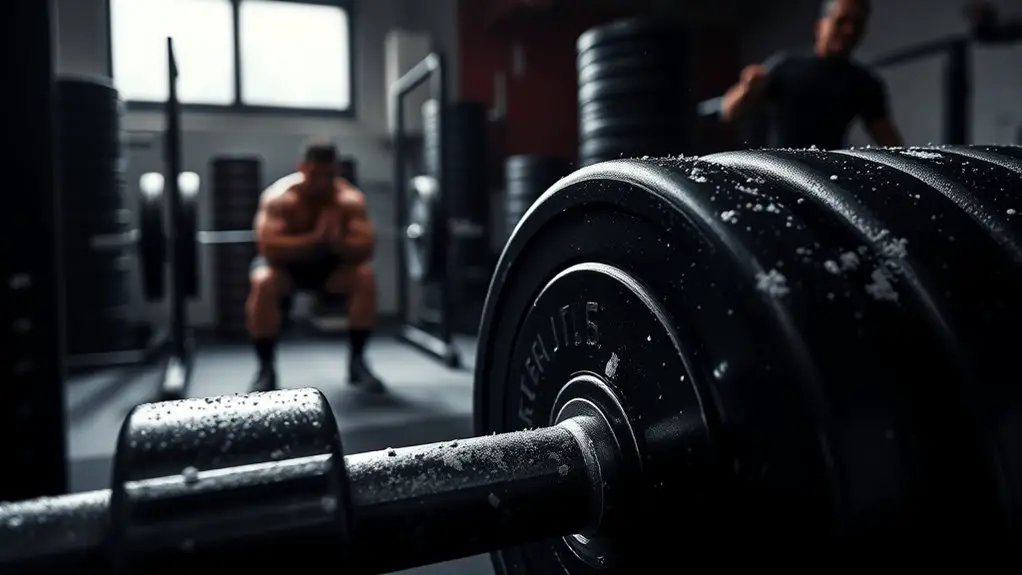
When you immerse yourself in powerlifting, it’s essential to understand the three main lifts: squat, bench press, and deadlift. Each lift has its own nuances, and mastering them can enhance your performance while keeping you safe. For squats, consider squat variations like front squats and box squats to build strength while minimizing injury risk. When it comes to the bench press, focus on bench press techniques such as maintaining a stable grip and proper elbow positioning to protect your shoulders. Finally, adhere to deadlift principles by ensuring your back stays neutral and using your legs to initiate the lift. Implement lift specific strategies, like progressive overload and proper warm-ups, to prepare your body. Prioritizing safety and technique will not only improve your lifts but also help you avoid setbacks. Remember, a solid foundation in these lifts sets the stage for successful training and competition.
Designing Your Training Program
Designing your training program is vital for maximizing your performance in a powerlifting competition. To guarantee safety while pushing your limits, consider incorporating periodization methods. These methods allow you to cycle through different training phases—like hypertrophy, strength, and peaking—so you can avoid overtraining and reduce injury risk.
Next, pay attention to your training volume, which refers to the total amount of work done during your sessions. Balancing volume is important; too much can lead to fatigue, while too little might not yield progress. Aim for a mix of heavy, moderate, and lighter sessions to help build strength without overloading your body.
Lastly, listen to your body. If you’re feeling fatigued or sore, don’t hesitate to adjust your program. Prioritizing safety will help you stay healthy and perform your best on competition day.
The Importance of Technique and Form
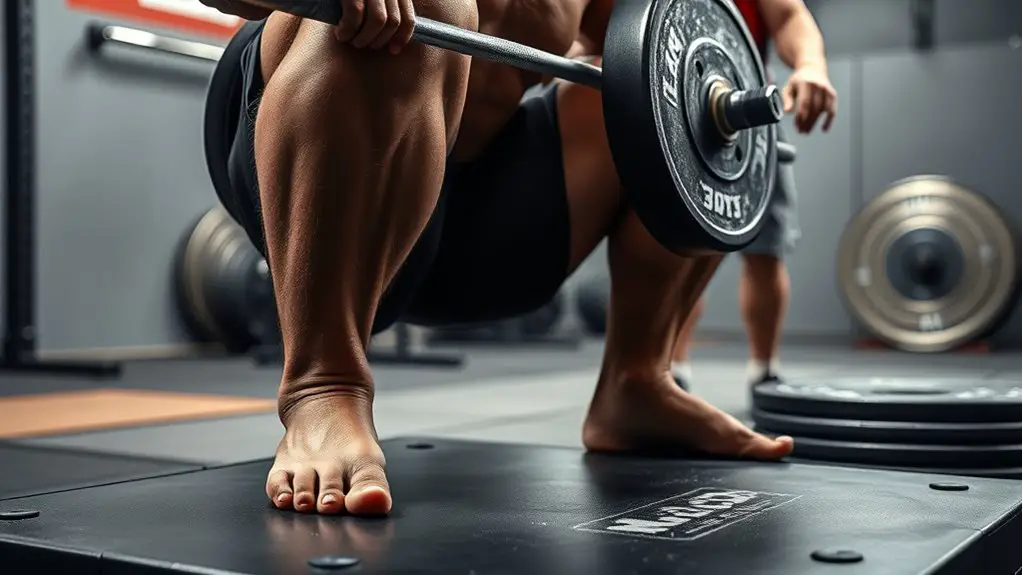
When it comes to powerlifting, technique and form are essential for your success and safety. Proper lifting mechanics not only help you lift more efficiently but also play a key role in preventing injuries. Staying consistent in practicing good form will set you up for long-term gains in your training.
Proper Lifting Mechanics
While many athletes focus on lifting heavier weights, mastering proper lifting mechanics is essential for both performance and injury prevention. Start by establishing a solid lifting stance, ensuring your feet are positioned comfortably and aligned with your hips. This foundation helps you maintain balance and stability during lifts. Next, pay attention to grip width; it can greatly affect your lifting efficiency and safety. A grip that’s too wide or too narrow can lead to strain or improper form. As you lift, keep your back straight, engage your core, and drive through your heels. Prioritizing these mechanics not only enhances your strength but also keeps your body safe, allowing you to progress effectively in your powerlifting journey.
Injury Prevention Strategies
Mastering proper lifting mechanics plays a significant role in injury prevention strategies. To keep yourself safe, always incorporate effective warm up routines that prepare your muscles and joints for the demands of powerlifting. Focus on mobility exercises to enhance flexibility and stability, reducing the risk of strains or injuries. After workouts, don’t skip recovery techniques like stretching or foam rolling, which help alleviate tension and promote healing. Additionally, conduct regular injury assessments to identify any potential issues before they escalate. By prioritizing technique and maintaining a proactive approach to your training, you’ll not only improve performance but also safeguard your body against common injuries in powerlifting. Remember, a strong foundation in safety is essential for long-term success.
Consistency in Practice
Consistency in practice is fundamental for developing the proper technique and form in powerlifting. By sticking to a well-structured training schedule, you can enhance your practice frequency, allowing for effective habit formation. Focus on skill mastery by emphasizing correct form during each lift, which is essential for safety and performance. Maintaining training logs is important for performance tracking; it helps you identify areas for improvement and reinforces workout discipline. Establishing a routine not only boosts your confidence but also minimizes the risk of injury. Remember, the more consistent you are in your training, the stronger and more skilled you’ll become. Prioritize technique over weight to guarantee long-term success in your powerlifting journey.
Incorporating Accessory Exercises
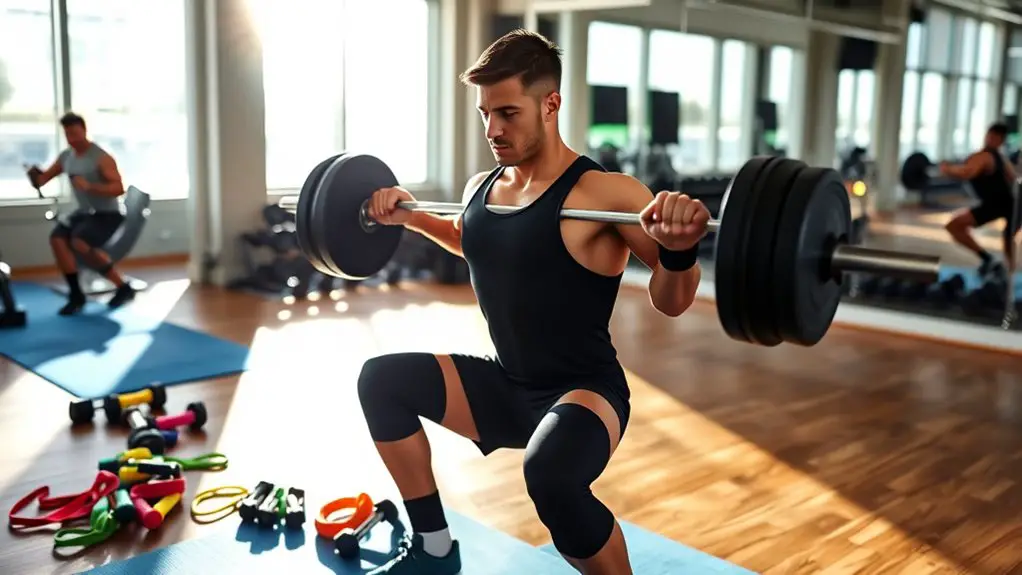
Incorporating accessory exercises into your training routine can markedly enhance your performance in a powerlifting competition. These accessory lifts help address muscle imbalances and improve strength ratios, which are vital for lifting heavier weights safely. When selecting exercises, focus on those that complement your main lifts and improve functional strength, like rows or overhead presses.
Utilizing proper equipment is essential to guarantee safety and effectiveness. Incorporate these lifts into your training volume carefully, integrating them into your periodization strategies to avoid overtraining. Balance your primary lifts with complementary workouts to promote recovery and muscle development.
Don’t forget to establish recovery protocols between sessions, as this will aid in maintaining your overall performance. By thoughtfully incorporating accessory exercises, you’ll build a more robust foundation, ultimately enhancing your competitive edge while reducing the risk of injury.
Nutrition for Optimal Performance
While accessory exercises play a significant role in building strength, your nutrition can make or break your performance in a powerlifting competition. Focus on meal timing to guarantee you’re fueled for training and competition day. Achieving macronutrient balance is essential; prioritize proteins, carbs, and fats in your meals. Hydration strategies should include drinking enough water before, during, and after your workouts.
Pre workout nutrition is crucial—consume easily digestible carbs and protein to maximize energy. After training, prioritize post workout recovery with a mix of protein and carbohydrates to aid muscle repair. Don’t forget about calorie adjustments; as your training intensity increases, so should your intake.
Make thoughtful food choices that align with your goals, and consider supplement choices that support your performance, like creatine or BCAAs. Finally, effective meal prep can save time and guarantee you stick to your nutrition plan.
Mental Preparation and Mindset Strategies
Mental preparation plays an essential role in your success at a powerlifting competition. You can enhance your performance by using visualization techniques, building resilience, and setting realistic goals. Let’s explore how these mindset strategies can help you lift your best on competition day.
Visualization Techniques for Success
How can you tap into the power of your mind to enhance your performance in a powerlifting competition? Visualization techniques can be a game-changer. Start with visualization exercises that involve imagining yourself executing each lift perfectly. Picture the barbell, the weight, and the setting. Use mental imagery to create a vivid scene where you feel strong and confident. This practice can help reduce anxiety and build a sense of familiarity with the competition environment. Set aside time to visualize daily, focusing on your technique and breathing. Remember, it’s not just about lifting weights; it’s about believing in your ability to succeed. With consistent mental preparation, you’ll feel more grounded and ready to tackle any challenge on competition day.
Building Resilience and Focus
Visualization techniques lay a strong foundation for mental preparation, but building resilience and focus takes your performance to the next level. Cultivating mental toughness is essential; practice positive affirmations daily to reinforce your self-belief. Incorporate focus techniques, like concentration exercises, to enhance your ability to stay present during training and competition. Utilize mindfulness practices to manage stress and maintain emotional resilience, helping you stay calm under pressure. When setbacks occur, view them as opportunities to learn and grow, reinforcing your determination. Remember, resilience is about bouncing back stronger. By prioritizing these strategies, you’ll create a powerful mindset that not only prepares you for competition but also supports your overall well-being and safety in your powerlifting journey.
Setting Realistic Goals
Setting realistic goals is essential for maintaining motivation and progress in your powerlifting journey, especially when you’re facing the challenges of competition. Start by establishing clear, achievable benchmarks that align with your current abilities. This means setting realistic expectations for your lifts, rather than aiming for numbers that could lead to injury or burnout. Break down your larger goals into smaller, manageable steps, which allows for consistent goal setting and helps you track your progress safely. Celebrate those small victories to boost your confidence and keep you engaged. Remember, the more sensible your goals, the more likely you are to stay committed. Prioritize your well-being and build a strong foundation, ensuring you’re prepared for competition while minimizing risks.
Tapering Before the Competition
As you approach the final weeks leading up to your powerlifting competition, tapering becomes essential for optimizing your performance. Tapering strategies involve gradually reducing your training volume while maintaining intensity. This not only helps prevent fatigue but also allows your body to recover fully. During this phase, focus on incorporating recovery techniques like foam rolling, stretching, and adequate sleep to enhance muscle repair.
You might want to decrease your training sessions to three or four times a week, emphasizing lighter weights and perfecting your form. Pay attention to your nutrition, ensuring you’re fueling your body with the right nutrients. Hydration also plays a critical role in recovery, so keep your water intake high. Listen to your body—if you’re feeling overly fatigued, consider taking an extra rest day. By effectively tapering, you’ll feel refreshed and strong, ready to give your best performance on competition day.
What to Expect on Competition Day
When you arrive at the venue on competition day, excitement and nerves are likely to mingle as you prepare for the challenges ahead. Embrace the competition atmosphere; it’s an experience unlike any other. You’ll find a supportive lifting environment, but remember to follow competition etiquette to guarantee a smooth day.
Here’s what to expect:
- Warm up routines: Stick to your plan to keep your muscles primed and ready.
- Equipment checks: Make sure your gear meets the judging criteria, guaranteeing you’re compliant.
- Mental challenges: Combat performance anxiety by focusing on your breathing and visualization techniques.
- Athlete camaraderie: Share your personal experiences with fellow lifters, fostering encouragement and support.
Stay focused, trust your training, and remember that every competitor faces similar mental hurdles. Enjoy the day; it’s a celebration of hard work and dedication!
Frequently Asked Questions
How Do I Choose the Right Powerlifting Federation for Competition?
Choosing the right powerlifting federation’s essential for your success and safety. Start by reviewing each federation’s rules, as they can vary considerably. Reflect on which competition categories suit your goals and experience level. It’s also important to take into account the federation’s reputation for safety measures and fair judging. Make sure you’re comfortable with their guidelines and support, so you can focus on lifting without any worries. Select one that aligns with your values and aspirations.
What Gear Do I Need for My First Powerlifting Meet?
For your first powerlifting meet, you’ll need some essential gear to guarantee safety and performance. Start with lifting shoes, as they provide the stability and grip you need. Knee sleeves are also vital; they offer support and warmth to your joints during heavy lifts. Don’t forget a weightlifting belt for added core stability and wrist wraps for extra support. Having the right gear will help you feel confident and secure on the platform.
Can I Compete Without Prior Experience in Powerlifting?
Yes, you can compete without prior experience in powerlifting! Many competitions welcome beginners. Just make certain you follow beginner guidelines to guarantee safety and proper technique. Focus on building your strength and understanding the lifts. It’s important to assess your competition readiness by practicing regularly and maybe even working with a coach. This way, you’ll feel more confident and prepared when you step onto the platform. Enjoy the journey and have fun!
How Should I Handle Nerves Before My Lifts?
Handling nerves before your lifts is essential for a strong performance. You can start by practicing breathing techniques; take deep, slow breaths to calm your mind and body. Mental visualization’s also helpful—imagine yourself successfully completing your lift, focusing on the details. This can boost your confidence and reduce anxiety. Remember, it’s natural to feel nervous, but with these strategies, you’ll be better prepared to channel that energy into your performance.
What Are Common Mistakes to Avoid on Competition Day?
On competition day, you want everything to go smoothly, right? So, avoid forgetting your warm-up routine—it’s essential to prepare your body. Also, double-check your equipment checklist; nothing’s worse than realizing you’ve left your belt or shoes at home. Stay calm and don’t rush; it’s easy to get caught up in the excitement. Remember, being organized and sticking to your plan can help you lift safely and effectively.



